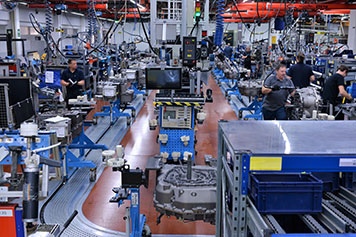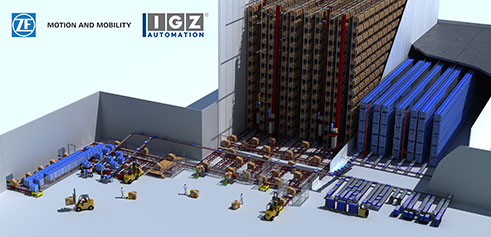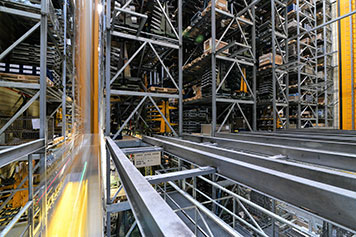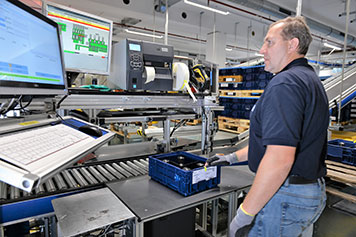SAP EWM/MFS supplies parts to Zack | IGZ

The division of industrial technology of from ZF Friedrichshafen AG has increased warehousing performance by introducing central warehousing and automation of logistics at the Passau site. Even more ambitious goals, such as significant reduction of recovery times, were surpassed by far with IGZ support.
As the airship pioneer Ferdinand von Zeppelin established a "Zahnradfabrik" in 1915, he thus laid the foundation for a modern multi-billion company with approximately 230 locations worldwide. The division Industrial Technology that bundles all activities for applications "off the road" in the ZF Friedrichshafen AG is coordinated from Passau. Gearboxes and axles for land and construction machinery, propulsion technologies for truck and rail - and special-purpose vehicles are developed and produced. In addition, the division is responsible for global business in marine and aviation technology, as well as in the manufacture of gearboxes for wind turbines and industrial drives.

For more than 30 years, the high-bay pallets warehouse built in 1983 was a distinctive landmark in the region. Since the front part was completely dismantled in 2014 and the remaining intra logistics gradually modernised, this old building is now historic. Since August 2015, the first construction stage with the modernized high-bay warehouse and the new pallet conveying system is in operation. In a second construction phase, an automated small parts warehouse, has finally started operation in April 2016, from where the performance centre assembly at the ZF site in Passau is supplied with material. The overall system is managed and controlled with the system SAP EWM (extended warehouse management) including SAP MFS (material flow system), supported by the SAP engineers of IGZ, the SAP EWM general contractor.
Logistics is fully readjusted

"To ensure the supply of parts in the long term, we had to consistently put our logistics on new feet", says Daniel Biefeld, ZF project manager. Due to the long service life of the high-bay warehouse, not only the technical performance limit was reached. "To maintain the required throughput of 70 pallets per hour, we were forced to switch to an asynchronous supply in three-shift operation", say the ZF logistics expert.
The pressure to act was strengthened by outdated decentralised warehousing structures. About 60% of the supplied volume almost bypassed the warehouse; the stocks piled up at the 26 assembly lines. Against this background, the demand was formulated to change from traditional direct supply strategy to central warehousing including consignment. The dispatch warehouses of subsidiary works should be dissolved and entirely more momentum created in the logistics process. The focus, in particular, was on replenishment time - and response time.
From the introduction of new standard software for warehouse management and control, officials anticipated a clear plus in transparency over the stocks in conjunction with continuous traceability. In modernised high-bay warehouse, which has a capacity of approximately 9150 slots, a storage and retrieval performance of up to 160 pallets per hour is possible today. In 44,000 slots, the small-parts warehouse generates a throughput of about 600 containers in the same period. All processes in the performance centre for assembly, from lorry registration via storage and route train loading up to the assembly, are integrated directly in SAP EWM.
This solution was initially not necessarily used. "The functional call for tenders for the new logistics centre was first used as a black box and was sent out mid July 2014 to over ten potential providers", explains Daniel Biefeld. In a workshop in the framework of SAP usage analysis, IGZ finally demonstrate the advantages of an SAP EWM-based solution. The option SAP EWM was added consecutive short-term functional tender. For example, sustainability and increased market penetration of the software solution, as well as the fact that required extensions and optimizations were already covered in the standard.
Here, the SAP engineers from Falkenberg in the Upper Palatinate were again persuasive. "IGZ has a really strong and permanent SAP EWM developer force with more than 150 specialists and it can present reference projects in mechanical and automotive engineering with similar warehouse technology and process requirements," explains Biefeld. But also, the so-called soft facts have positively influenced the decision: "In the supplier talks, it was simply felt that IGZ brought the greatest motivation and new ideas. This was not only my subjective feeling, but corresponded to the objective perception of all those involved on the part of ZF.“
SAP EWM-pioneer at ZF
The decision per SAP EWM marks an important milestone in the history of ZF Friedrichshafen. Because this IT solution is used throughout the group for the first time. Thus, the location of Passau has become a pioneer in the world of the ZF logistics. Complementing the commission to implement a comprehensive SAP EWM integration, IGZ was awarded the contract as general contractor in October 2014 to retrofit the high-bay warehouse and the new building of the four-aisle automatic small parts warehouse.
The procurement of a contractor was already envisaged in the two-stage implementation strategy of the project "Logistics Centre LC Assembly". Prerequisite for competition entry was a high implementation competence as a general contractor and as a logistics software specialist. The expert knowledge necessary for this can be found under the umbrella of the IGZ group in the IGZ Automation GmbH. "Our approach aims at being point of contact for all trades and also service providers in the event of servicing", says Alfred Meyer, Managing Director for the IGZ general contractor business. "We assume and coordinate the service transaction for mechanical plant, control and IT in all service-life stages of a plant."
Track record exceeds expectations

As the rule in project management practice, employees of ZF and IGZ together have undergone a "forming, storming, standardising and performing" at the team level, as Biefeld calls it. The big challenge was to translate the ambitious performance within a very tight time line from theory into practice. This could be solved successfully through commitment of all those involved in the project. Even short decision paths were always helpful. After completion of the project, also ZF Logistics Manager Kölbl emphasizes "IGZ has delivered top quality – the availability of the entire system is 100%!" The Go-Live of the construction phase 2 of the new central logistics centrum in Passau took place in March 2016.
The ZF executives are pleased with the achievements. Even if all dates were very athletic, the project has been implemented in the absolutely realistically possible scope. The current figures prove that the parameters for success assessment of the project have been exceeded and can be upheld in long-term. "With the old warehouse equipment, we stored and retrieved 55 small charge carriers and 15 large charge carriers per hour in peak hours", says Biefeld. With the support of SAP EWM, with which over 12,000 productive part numbers are managed, today 160 are handled in the high-bay warehouse and 600 in the automatic small parts warehouse. "Thus, we have increased the stock performance elf-fold."
The throughput time in the goods receipt was reduced to eight hours a day, the replenishment time of goods at the performance centre from 24 to 4 and the reaction time of the logistics at quick pace today is just a quarter of an hour. Its stated goals are thus exceeded significantly. In parallel, in the sense of a lean production, space could be created in the assembly hall. The space savings through reduced stocks in the goods receipt amounts to 1,400 m². This space can now be used productively otherwise.
Fit for the change in the markets
Absolute transparency of inventory is another advantage. Batches and their history are likewise visible as well as the content of the so-called handling units, units of packaging and included goods. As an additional highlight, Daniel Biefeld calls the intelligent dynamic tugged train system, developed jointly with IGZ for the supply of material, which does not follow any timed schedule. "Thus, we swap the material completely automatically in the loading order transport it on dynamic routes in the assembly hall as a shared taxi and are under way with minimum equipment and small personnel expenses", says the ZF project manager.
A lot has changed also for the employees. The working environment is now perceived significantly more positively. A significant share is contributed by terminals that are easy and safe to use - thanks to touch-screen interface. Last but not least, the reorganisation of ZF logistics in Passau has motivation-enhancing effect. Upon the initiative of employees, already further selective optimisations could be made. In overall, with the new logistics centre, we are equipped very well for the next 10 to 15 years, also because the system is scalable and upgradeable. "When developing the usage concept, we have provided various extension options for the automatic small parts warehouse" underlines Alfred Meyer. Volumes will rise, processes will change - all participants are well prepared.
Back to overview

